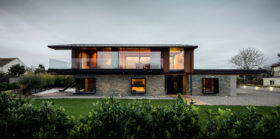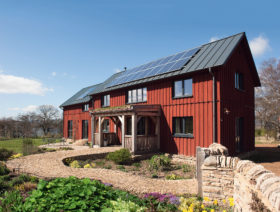

Settling on where to put down roots following retirement wasn’t a particularly difficult decision for Keith and Mairi O’Connor. The couple were lucky enough to already own a two hectare site on the picturesque Lochaber coast, where Keith had holidayed since his youth, as they had purchased a tranche of land here from a friend some years previously.
The pair had brought their own family to the area for breaks, too, staying in a neighbouring static caravan. So all-in-all, the choice of location for their new house was a bit of a no brainer.
“This is a beautiful setting, with open vistas across Loch Ailort and spectacular sea views towards the isles of Eigg and Rum,” says Mairi. “It was always our aim to build a long-term home here – although it was a bit of a gamble, as there was no planning permission in place.”
Despite this potential stumbling block, the couple had spent years collecting ideas. “Keith’s job in the oil industry has taken us all over the world, from Southeast Asia through to Houston and Caracas,” says Mairi. “We’ve lived in so many houses and taken a lot from those experiences, but the main idea for our new place stemmed from the ticking of the clock. Fortunately, we have similar tastes – and we were keen to create something that had a single storey, with wide corridors and no stairs.”
The project took a huge step in the right direction when Glasgow-based architect Ewan Cameron, who has a long familial association with this particular part of the Highlands, spotted the couple’s advert via online portal Service Start.
“The Lochaber coast is my heartland,” says Ewan. “When I first drove up in the sleet to meet Keith and Mairi, I tried to convey my passion for the area. I felt I could help them achieve the house they wanted: something simple and low-key. They’re very much part of the local community, so they wanted the property to be integral to its surroundings rather than a grand gesture.”
One of the couple’s goals was to create generous living spaces that would maximise the amazing vistas. For Ewan, that meant working backwards and designing the house sequentially based on where you’d like to sit at different times of the day. “You can see yourself having a dram, glass of wine or cup of coffee in a spot like this,” he says.
To help smooth the way for the scheme, Ewan began an early dialogue with the local planners. “They asked us to keep the height of the building as low as possible, as they didn’t want it to be too visible from the road,” he says.
The final drawings were for an L-shaped dwelling inspired by Kyoto pavilions. “They create a frame from which to contemplate nature,” says Ewan, who experienced this design philosophy whilst working in Asia. “In this case, the beauty of the Atlantic views contrasts with the intimate sheltered courtyard, while the modest form and palette of external materials ensure the building has minimal impact on the natural rock and heather surroundings.”
The right-angled footprint means that both the living and sleeping wings look onto the landscape. “When you arrive at the house at the top of the hill, you don’t really see anything – just the sheltered courtyard. It’s tantalizing,” says Ewan. “Then you step through the entrance and spectacular ocean views open up in front of you.”
Whilst the design was simplicity itself, and planning was granted in just two months with little fuss, the construction phase wasn’t without its challenges. In order to open up the views to the living room and establish the fully level plateau required for the building, there would need to be substantial excavations into the rock.
All told, 3,500 tonnes were removed from the plot. A new road, built up to the site prior to construction, proved a godsend both for this and later phases of the work, as most of the vehicles required were robust enough to make the climb from the coastal road. But the excavations still added six months onto the schedule.
The drawn-out process was a far cry from the main building phase, with a timber frame superstructure ensuring this part of the project was completed super-fast. This was packed with high-quality Kingspan insulation and fitted with Passivhaus-standard windows.
Despite the fact that around 40% of the property is glazed, it still achieves fantastic thermal performance thanks to the triple-glazed, alu-clad NorDan fenestration, which features a low-emissivity coating and hits U-values (a measure of heat loss, where smaller numbers are better) of just 0.7 W/m2K. The glass wall elements are juxtaposed with vertical board-on-board Siberian larch cladding, which lends the building a simple agricultural feel.
One of the advantages of incorporating so much glazing is that the property enjoys a huge amount of passive solar gain – especially via the south-facing corridor that leads to the bedroom wing. This effectively acts as a free source of warmth, helping to lessen the need to rely on conventional heating – thereby reducing the couple’s carbon footprint and keeping a lid on energy bills. In fact, they’ve hardly had to switch the underfloor heating on at all.
“Ewan came up with the idea and it works really well,” says Mairi, who’s also delighted with how light and airy the house feels. “The winter sun may toil to reach the building, but with the amount of glazing and reflections from the sea it’s always bright. The quality of light in the house is beautiful throughout the day.”
The pared-back look extends to the interiors, too, reflecting the ethos of the scheme. “We weren’t here to make a statement. This is a very simple house that doesn’t battle against the landscape,” says Mairi. “We’ve always adored the feel of this part of the west coast of Scotland, especially the light and the views. Everything was designed around this.”
White walls are teamed with oak doors and floors to provide a neutral, natural backdrop for the artworks, ceramics and musical instruments (Keith is a keen percussionist) the couple have picked up during their travels. “The hardest thing was sourcing the right materials and products for the interiors,” says Mairi.
It helped that they were able to take their time over these choices, as they stayed in their previous home in Aberdeen throughout the works. “There was no rush to get it finished,” says Mairi. “We’re not DIYers so didn’t stay in a caravan or anything like that, which would have taken a lot of the joy out of the build for us.”
Nevertheless, the O’Connors were on site on a regular basis throughout the work to keep things ticking over. Apart from the excavation delay, it all went pretty much to plan. “We were more or less able to stick within our original budget; we only ran slightly over with the kitchen,” says Mairi.
Now that they’ve moved in, the couple have turned their attention to the landscaping around the house. “It’s a work in progress,” says Mairi. “We didn’t want big swathes of formal garden as this place is so beautiful and rugged. But we made a few little flowerbeds with sweet peas and honeysuckle. My biggest joy is the vegetable patch.”
They’ve also installed a deer fence to protect the flora. “The whole hill has regenerated since before we began the works,” says Mairi. “The heathers that were on the site before we began construction have returned and we’ve also planted around 1,000 native trees – including oak, birch, and hazel. These were grown on the Isle of Eigg and brought over and planted by a friend on the island.” The trees act as a natural windbreaker for the exposed site.
The elevated location has given rise to another unexpected – yet highly satisfying – element of the scheme for architect Ewan, who was able to spot the lights of the O’Connors’ home at night whilst visiting family on Eigg, which is 20km to the west. Not that creating a landmark building was something he’d originally envisaged.
“I see the dwelling as a facilitator,” he says. “It’s not something to be stared at; it’s about creating a place where Keith and Mairi can enjoy this beautiful landscape.”

